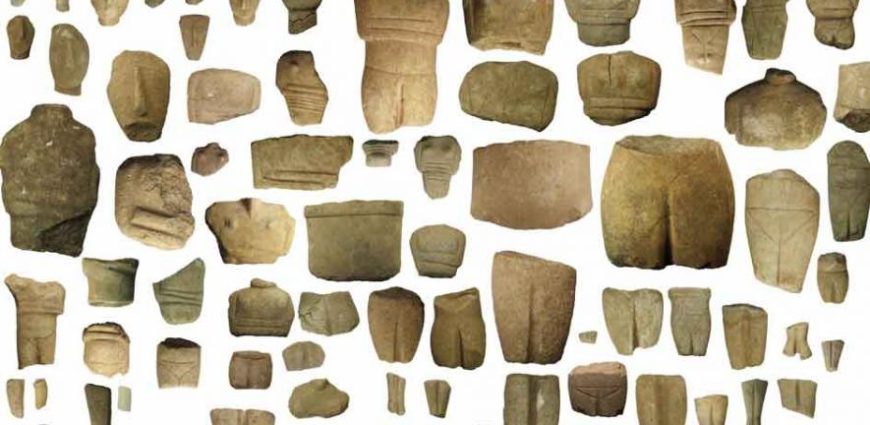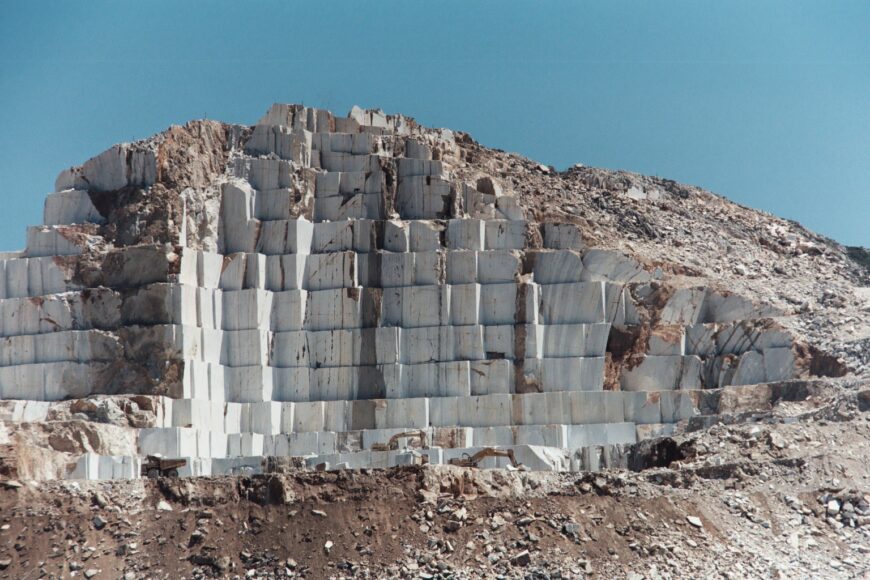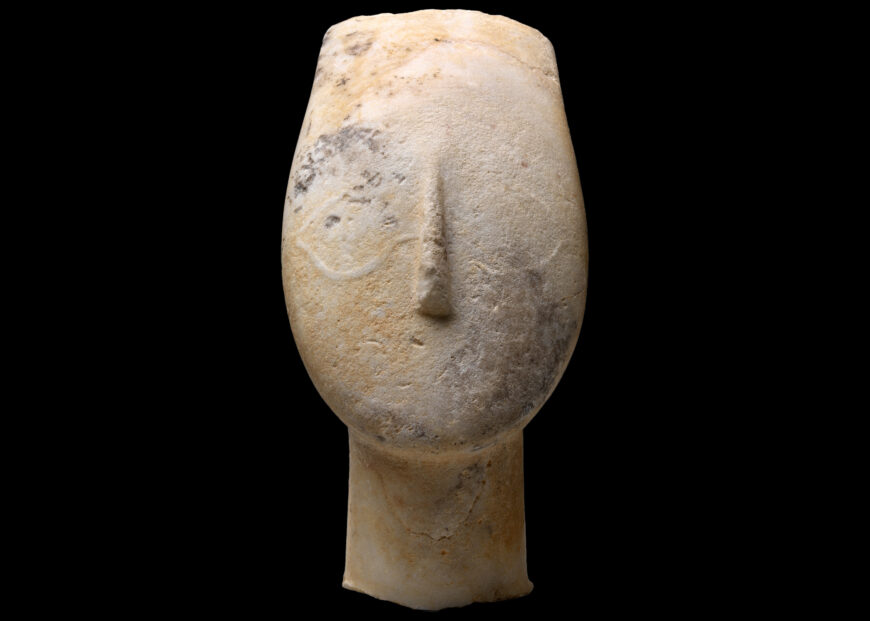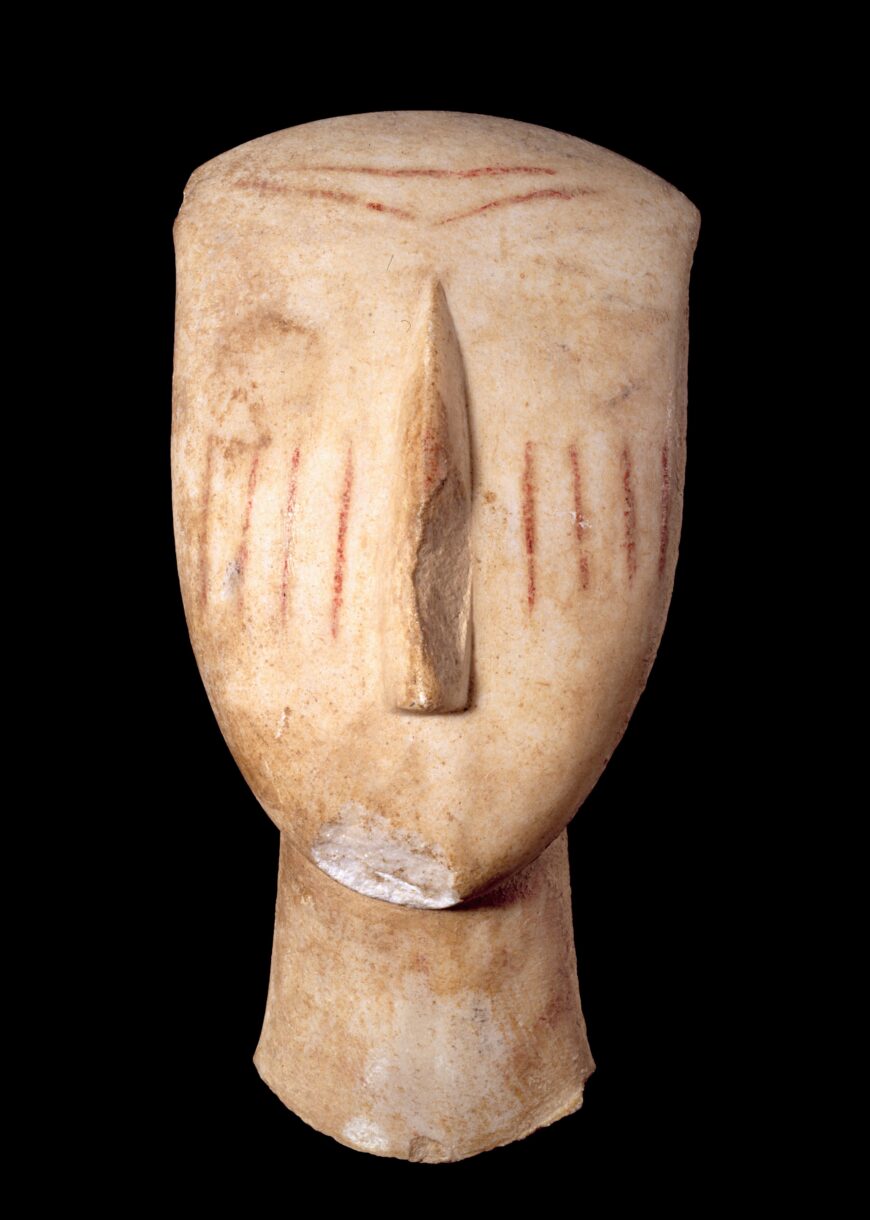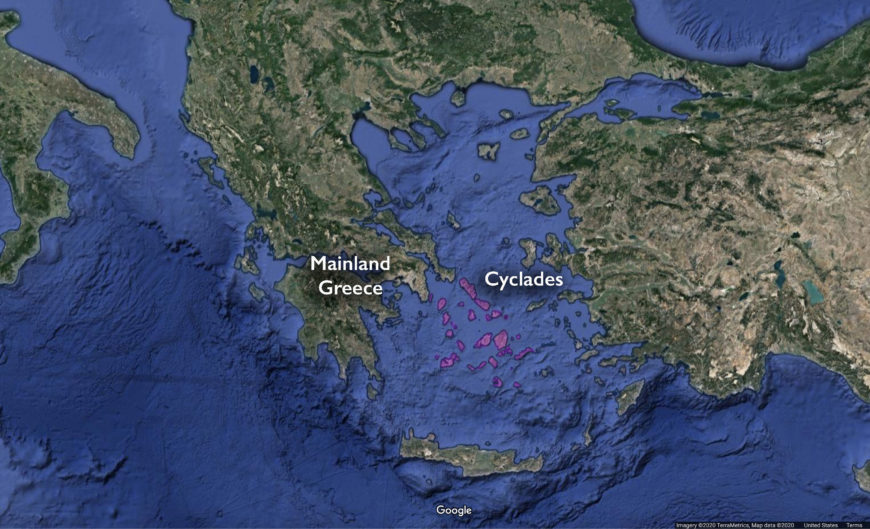
Map of the Cyclades (© Google)
The Cyclades (often referred to as the Greek Islands) are a group of islands to the southeast of Mainland Greece in close proximity to one another, so much so, from each island you can nearly always see at least one other. This capacity to see each other, and invite travel between them, resulted in a common culture growing up among these islands in the Early Bronze age (around 3000 B.C.E.). For the next thousand years, until about 2000 B.C.E small farming settlements grew into large towns with neatly built stone buildings. Metal smelting became common and trade flourished with not only the mainland of Greece but also Crete and the Anatolian coast (today, Turkey).
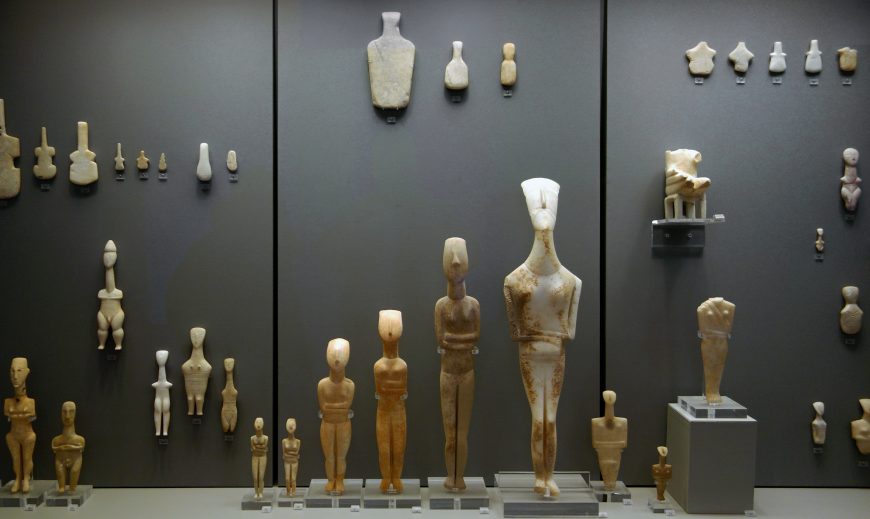
Cycladic period figures, marble (National Archaeological Museum, Athens)
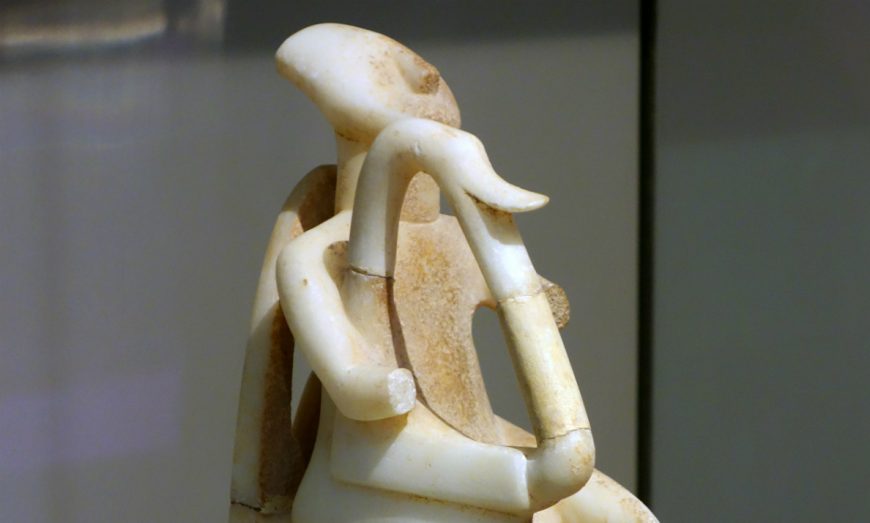
Male harp player from Keros, c. 2600–2300 B.C.E., Early Cycladic period, marble, 22.5 cm high (National Archaeological Museum, Athens)
Found in the tombs
The Early Bronze Age people of the Cyclades had a unique way of burying their dead, in stone slab lined pits, sometimes in two stories. But, what is really remarkable is what has often been found in these tombs: elegantly carved small-scale marble sculptures, nearly all of women, known as Cycladic figurines. These form the first stylistically coherent sculptural type to develop in Europe and have featured prominently in the prehistoric art history of Greece. Several Modern artists were influenced by Cycladic figurines as well, including Pablo Picasso, Constantin Brâncusi, and Amedeo Modigliani.
The use and meaning of these sculptures have been a mystery since their first discovery at the end of the 19th century. The fact that some 75% of Early Cycladic archaeological sites have been looted in search of figurines to sell on the antiquities market hasn’t helped; looting destroys the contextual information which enables us to understand artifacts. However, recent archaeological excavations on the island of Keros, have produced some fascinating information. Specifically, at the site of Dhaskalio-Kavos two large deposits have been found filled with hundreds of figures which were all purposefully broken in the Early Bronze Age before their burial. Archaeologists believe that the site was an important religious sanctuary which drew people from all over the Cyclades.
The dynamic early Bronze Age culture of the Cyclades ends abruptly, around 2000 B.C.E., when all settlement sites are abandoned. The reason for this abandonment remains a mystery. People don’t again settle on the islands in large numbers for another two hundred years.
Additional resources:
Early Cycladic Art and Culture on the Metropolitan Museum of Art’s Heilbrunn Timeline of Art History
David W. J. Gill, and Christopher Chippindale, “Material and Intellectual Consequences of Esteem for Cycladic Figures.” American Journal of Archaeology, vol. 97, no. 4 (1993), pp, 601-59
Marisa Marthari, Colin Renfrew, Michael J. Boyd, eds., Kavos and the Special Deposits: The sanctuary on Keros and the origins of Aegean ritual (Oxbow Books, 2016)
Marisa Marthari, Colin Renfrew, Michael J. Boyd, eds. Early Cycladic Sculpture in Context (Oxbow Books, 2017).
Keros Project
The Marble Finds from Kavos and the Archaeology of Ritual
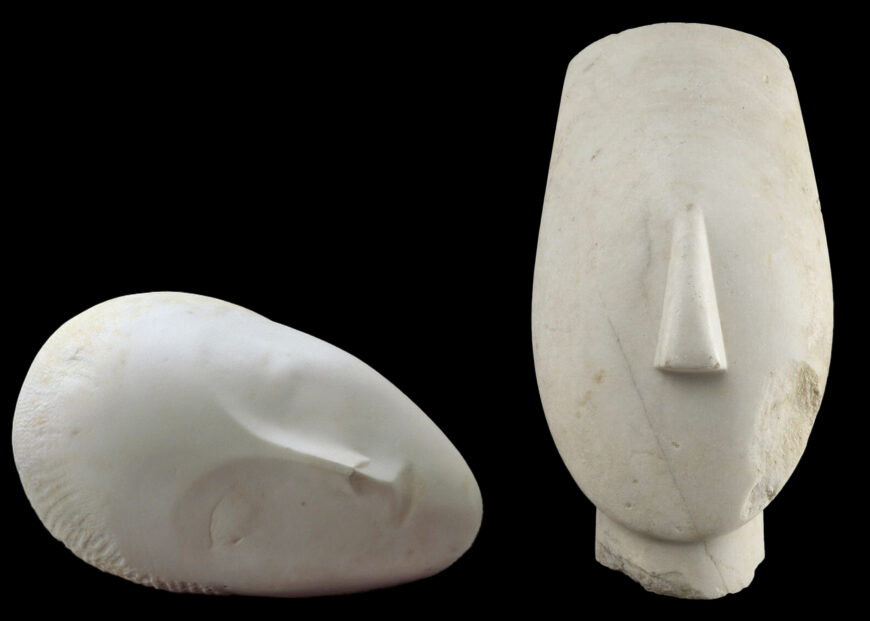
Left: Constantin Brȃncuși, Sleeping Muse I, 1910, marble, 17.2 x 27.6 x 21.2 cm (Hirshhorn Museum and Sculpture Garden, Washington, D.C.); right: Head of an Early Cycladic figurine, 2600–2400 B.C.E., marble, 14 x 27 x 10 cm (Musée du Louvre, Paris)
Consequences of collecting
In the early 1900s, as European artists explored new ways of representing the human form, many took inspiration from sculptures that were thousands of years old. Famous artists including Constantin Brȃncuși and Pablo Picasso were captivated by the sparse simplicity of marble figures made in the Cyclades between c. 3200 B.C.E. and 2300 B.C.E. [1] These ancient stone sculptures represent people simply. Their arms and legs are marked by incisions, often not even separated from the body. Their faces only have sculpted noses, while the rest of the facial features (once added in paint) are now usually invisible to the modern viewer. Although they are simplified, these statues are still easily recognizable as people. Their minimalism inspired modern artists and made the statues seem almost modern themselves, contributing to their popularity amongst collectors.
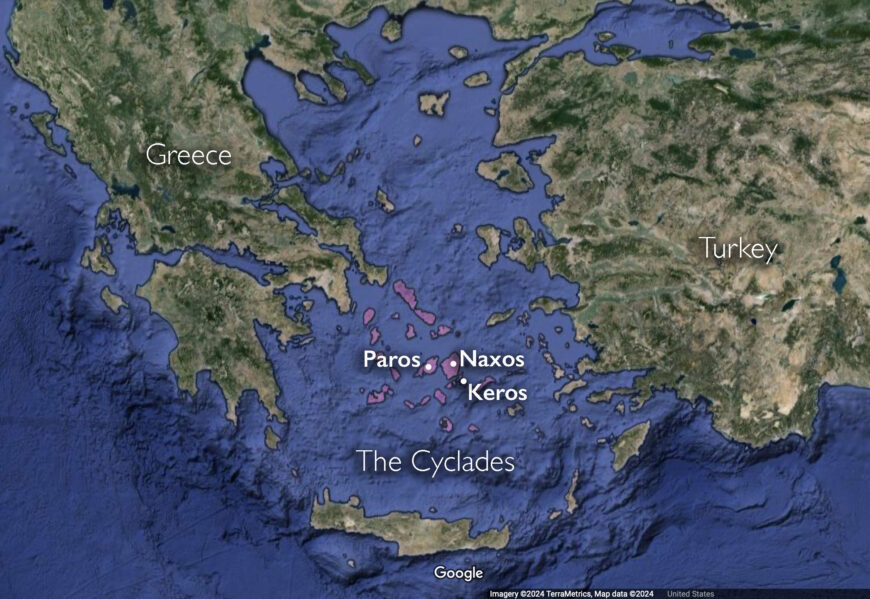
Map of the Cyclades (underlying map © Google)
In the 1950s and 1960s, Cycladic figures became immensely popular on the art market. Collectors paid millions of dollars to purchase Cycladic statues at auctions. The economic potential of these figures led looters to seek them out. Looters illegally removed hundreds of marble figures from the Cyclades, selling them to dealers who then realized significant profits. The popularity of Cycladic figures on the market has also resulted in a proliferation of forgeries. It is difficult to assess the true extent of this looting, but current statistics about the provenance of Cycladic figures give us an idea of how much damage it caused: although well over a thousand Cycladic figures are known today, only about 200 of them come from excavations conducted by trained archaeologists. [2]
The widespread looting of Cycladic statues had disastrous consequences for our understanding of them. When an artifact is removed from its original context by a non-expert, valuable information is lost. So many Cycladic figures entered modern collections without archaeological data that we are still unsure of what the statues’ identities and functions originally were. [3] In the following paragraphs, we will consider what we do know about Cycladic figures, including where they were made, how their appearances evolved over time, and what their forms can tell us about their possible original functions.
Natural resources on the Cyclades
The Cyclades’ natural resources enabled their inhabitants to make marble sculptures. People living in the Cyclades during the Early Cycladic period traveled between the islands regularly, trading with one another and acquiring materials from their neighbors. Many Cycladic islands have extensive supplies of high quality marble. While some small Early Cycladic figures might have been made from found pebbles or stones, other larger figures were probably crafted from thin blocks of marbles taken from quarries on Naxos or Paros. [4] Once an Early Cycladic craftsman acquired a piece of marble, he used tools made from hard, locally available materials (like obsidian) to carve it and incise details into its surface. [5] He then used emery, another mineral that is naturally prevalent in the Cyclades, to smooth the statue down to its final shape. [6] Finally, the statue was painted.
We do not have enough archaeological evidence to determine whether Early Cycladic craftspeople traveled between islands to work for different customers, or whether their products were traded by merchants. [7] Our understanding of Early Cycladic societies and sculptors is further limited because they did not use written language, and so left no written records for us to read. However, we do know that their work was facilitated by the rich natural world in which they lived.
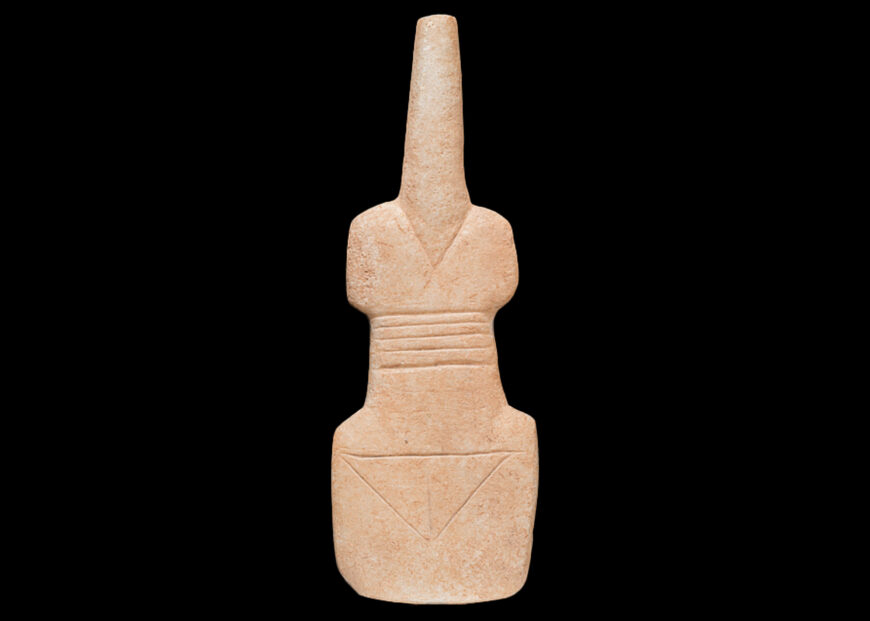
“Violin” type Early Cycladic figurine, 3200–2700 B.C.E., marble, 21.9 x 7.6 x 1.9 cm (The Menil Collection, Houston)
Stylistic simplicity in Early Cycladic figurines
Most Early Cycladic statues represent women. [8] The earliest Cycladic figurines tend to represent women in a more abstracted, schematic manner than their later counterparts. These early statues are often referred to as “violin” figurines because their overall shape recalls that of a violin. [9] One well-preserved example in the Menil Collection reveals how even these simplified violin figures can be recognized as female. Although the figure has no defined head or limbs, it does have an incised pubic triangle, marking it as a woman. These simplified violin figures were especially popular during the first phase of Early Cycladic culture, from c. 3200–2700 B.C.E. [10]
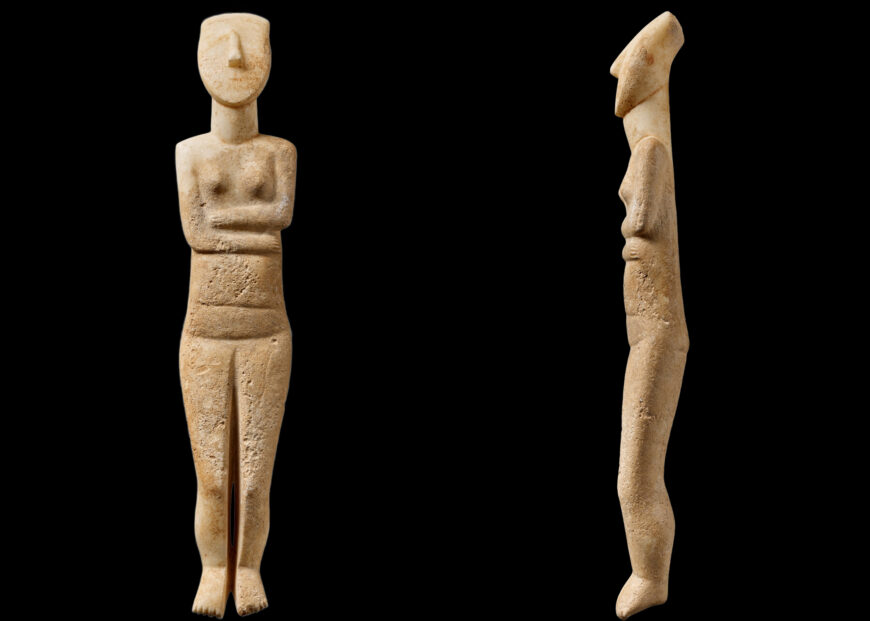
Front and side views of an Early Cycladic folded-arm figurine, 2700–2500 B.C.E., marble, 49.5 x 9 x 6 cm (The J. Paul Getty Museum, Los Angeles)
Around 2700 B.C.E., Cycladic sculptors developed a new kind of female figurine that soon came to dominate production. Today scholars refer to these statues as folded-arm figurines, or FAFs, because they are shown with their arms folded across their middles. [11] Although FAFs are simplified, they are more naturalistic than the violin figures that preceded them. We can see all of the typical features of FAFs on one statue in the Getty Museum. Overall, the figure is elongated. Its wedge-shaped head is tilted back and only its nose is sculpted. Other facial features that were originally added in paint have now mostly faded away. The woman has small articulated breasts, which indicate that she is female. Her arms fold over her abdomen, the left resting atop the right. Her legs are bent slightly at the knees and are not entirely separated from one another. When we consider the sculpture from the side, we see that its feet are not flat: the toes point slightly downwards. Like most other FAFs, this sculpture would not have been able to stand up on its own. Although modern museums often display FAFs upright, they must have been laid on their backs or propped up against walls in antiquity. [12]
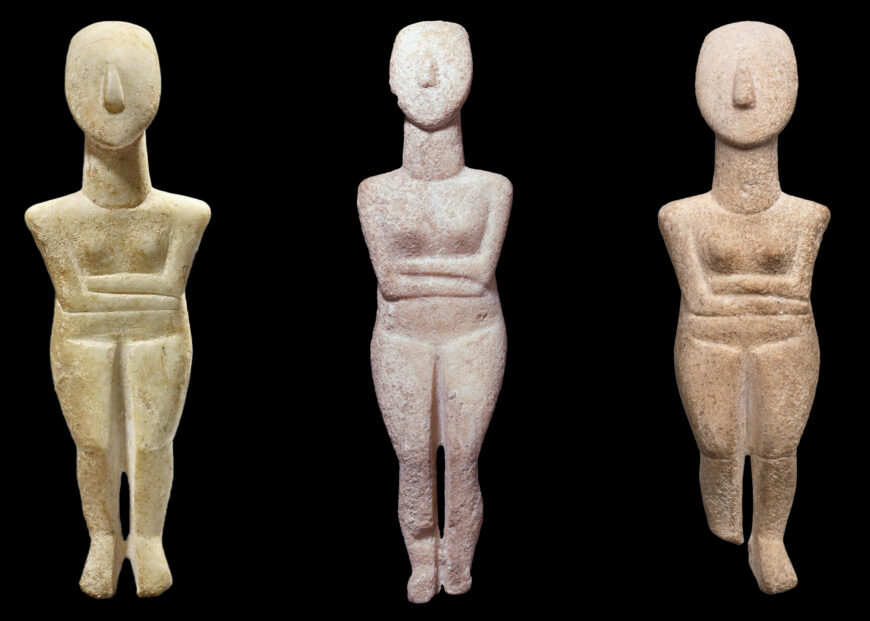
Left: The Bent Sculptor, Early Cycladic figurine, 2700–2500 B.C.E., marble, 17.1 x 5.7 x 2.9 cm (Musée du Louvre, Paris); center: The Bent Sculptor, Early Cycladic Figurine, 2700–2500 B.C.E., marble, 14.9 cm high (© The Trustees of the British Museum, London); right: The Bent Sculptor, Early Cycladic Figurine, 2700–2500 B.C.E., marble, 18 x 5.5 x 8.5 cm (Harvard Art Museums/Arthur M. Sackler Museum, Cambridge)
Cycladic sculptors made hundreds of folded-arm figurines between 2700 and 2300 B.C.E. [13] They are easily recognizable because of their basic shared characteristics, but they vary somewhat in their details and proportions. Our lack of understanding of these objects’ functions makes it difficult to explain these minor variations. However, some of these distinctive details may be the result of individual artisans’ preferences. In fact, some groups of folded-arm figurines are so similar to one another that art historians have proposed they are made by the same individual. One such craftsman has been named the Bent Sculptor after an archaeologist who worked in the Cyclades many years ago. [14] The Bent Sculptor’s folded-arm figurines are relatively stocky, with wide shoulders, narrow waists, and pointed chins. [15] While it is remarkable that we may be able to identify one person who made several Cycladic figures, the usefulness of this information is limited because we do not know where exactly the figures are from, and thus cannot determine where they were made or how they were used.
Painted people
Although a lack of archaeological context makes it impossible to determine the original functions of most Cycladic figures, some of the statues provide tantalizing clues on their own surfaces. The seeming simplicity of the folded-arm figurines is partially deceptive: nearly all of the figures were originally painted, particularly on their faces. In the Early Cycladic period, these figures had eyes rendered with bright red and blue paints made from local minerals. These painted decorations are often only barely visible today. Sometimes, the areas that were once painted appear slightly raised above the stone around them because the painted portion was protected by the (now missing) paint. [16] Such raised traces, which are called “ghosts” by archaeologists, are visible on the head of one figurine that is now in New York. The curving lines of the figure’s eyes are visible on either side of its slender nose, revealing that it once fixed viewers with an attentive stare.
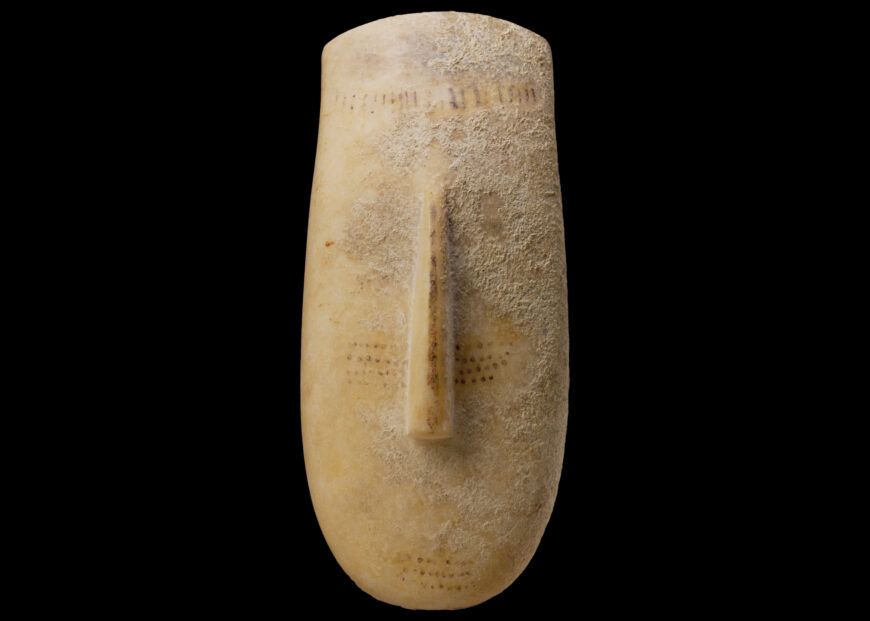
Head of an Early Cycladic figurine, 2600–2500 B.C.E., marble, 22.8 x 8.9 x 6.4 cm (The J. Paul Getty Museum, Los Angeles)
Many Cycladic figures have patterns painted on their faces. For example, a head that once belonged to an exceptionally large statue has a series of vertical red lines on its forehead, rows of red dots on its cheeks and chin, and a red stripe down its nose. These painted details do not correspond to facial features. They might instead relate to actual face painting rituals that may have been performed by Early Cycladic peoples during important life events. [17] In her groundbreaking interpretation of the paint on Cycladic figures, Gail Hoffman suggested that the statues were painted multiple times throughout their existence to reflect the changes their owners underwent. [18] A person might acquire a figure early in her life, painting its face with the markings she herself wore to her wedding when she got married, and later re-painting it with the patterns she wore during the dangerous time of childbirth.
Finally, when a person died, her figure might be repainted once more to depict a state of mourning. Several Cycladic figures with long vertical lines on their faces might reflect funerary rituals during which women lacerated their faces in anguish. [19] Other interpretations of the painting on Cycladic figures’ faces suggest that the markings reflect clan memberships. [20] Without written texts or more archaeological evidence, it is impossible to tell for sure what the markings mean.
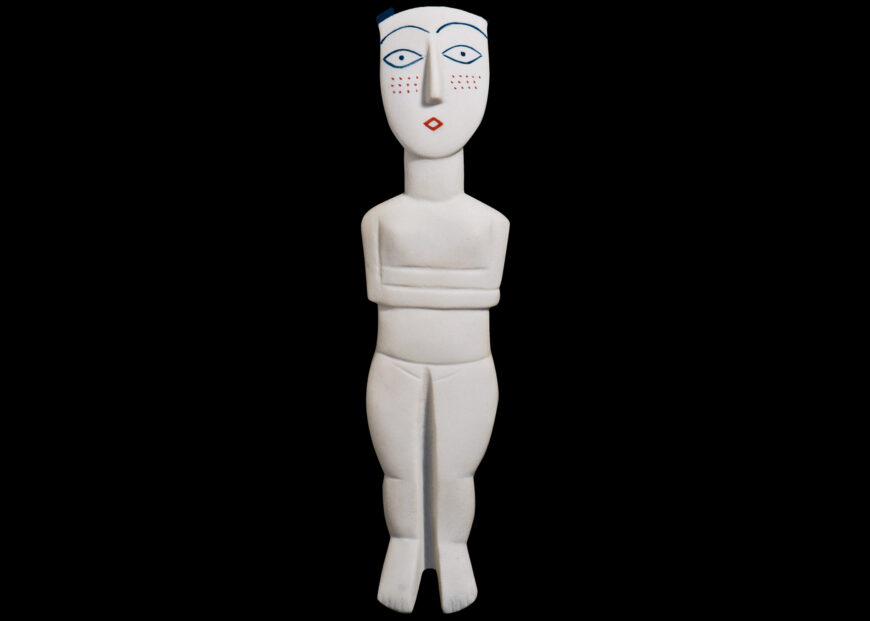
Reconstruction of a Cycladic figurine with paint by Vinzenz Brinkmann and Ulrike Koch-Brinkmann (Polychromy Research Project, Liebieghaus, Frankfurt)
Context clues
The few Cycladic figures that were excavated by trained archaeologists were mostly found in graves. Given this clue, and the fact that a few have been found painted with facial markings that might relate to mourning, it seems possible that some of the statues served a funerary function. However, only some excavated Cycladic tombs have figurines, and some very rich burials lack marble statues. Not all deceased elites needed marble figures in their graves. [21]
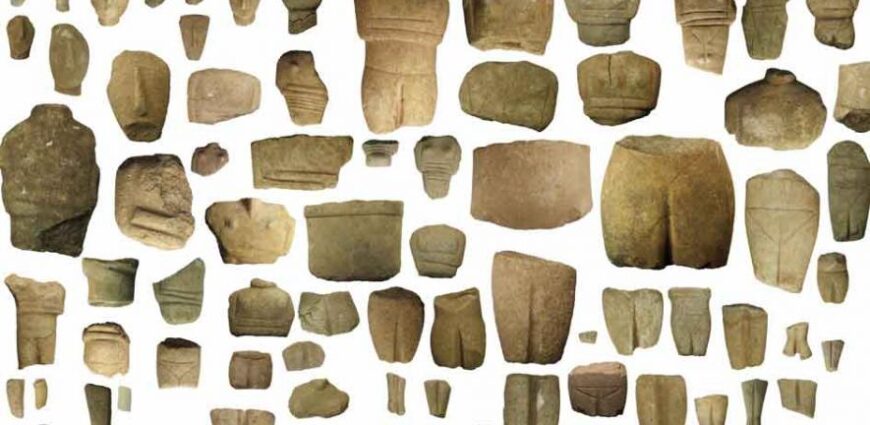
Fragments of Early Cycladic figurines found on the island of Keros (Island of Broken Figurines, Keros Project, Cambridge University)
In recent years, excavations on the island of Keros have revealed evidence that the marble figurines were used in rituals. Archaeologists have discovered hundreds of fragments of Early Cycladic statues buried in two closely related deposits on Keros. While one of these deposits has been extensively looted and essentially destroyed, the other is partially preserved, allowing archaeologists to study it more carefully. [22] The fragments found here come from hundreds of different Early Cycladic figurines. There is no evidence that the statues were broken near the deposit where they were buried. Moreover, the many fragments of figurines do not join with one another: they all come from different figures. Keros is a small island that did not have a large population in the Early Cycladic period. As a result, archaeologists believe that these deposits on Keros were a destination for people throughout the Cyclades. They suggest that Early Cycladic peoples may have broken their figurines at home, on whichever island they inhabited, and then carried a single piece of their figurine to the large deposits on Keros, where they buried them together with the many other fragments that accumulated over the decades. [23]
For now, any conclusions we reach about the original functions of these statues remain unconfirmed. New excavations shed more light on the figures’ significance, but extensive looting has resulted in an irreversible loss of knowledge. We can still appreciate the accomplishments of the craftsmen who created Cycladic figures. Using sparse, simplified forms, they crafted easily recognizable human figures with locally available materials. Although the Early Cycladic figurines’ exact functions are unknown, the great number of surviving examples and their relatively wide distribution throughout the Cyclades suggests that they were important to the islands’ inhabitants. As Alexander Aston has recently proposed, we might best understand them as material links in an imaginary chain that connected Early Cycladic peoples across the sea that separated them. [24] Even while living on different islands miles away from one another, these individuals all shared the ability to understand the marble figurines that circulated amongst them. As Early Cycladic peoples decorated their statues, buried them in graves, or left them in communal deposits on Keros, they remained connected through their shared use of the small marble figurines. Until the Early Cycladic culture came to an abrupt end around 2000 B.C.E. under mysterious circumstances, these statues were an essential part of its identity.
[1] David W. J. Gill and Christopher Chippindale, “Material and Intellectual Consequences of Esteem for Cycladic Figures,” American Journal of Archaeology, volume 97, number 4 (1993), pp. 605–06.
[2] Liam Devlin, “Antiquity Market Trends in Cycladic Figurines, 2000-19: Studies in Price, Prevalence, and Provenance,” International Journal of Cultural Property, volume 29, number 3 (2022), p. 320.
[3] Richard Neer, Art & Archaeology of the Greek World, 2nd edition (London: Thames & Hudson, 2019), p. 26.
[4] John Griffiths Pedley, Greek Art and Archaeology, 5th edition (Upper Saddle River: Prentice Hall, 2012), p. 37.
[5] Pedley (2012), p. 37.
[6] Pat Getz-Preziosi, Early Cycladic Sculpture: An Introduction, 2nd edition (Malibu: J. Paul Getty Museum, 1994), p. 51.
[7] Christos G. Doumas, Silent Witnesses: Early Cycladic Art of the Third Millennium B.C., exhibition catalogue (New York: Alexander S. Onassis Public Benefit Foundation, 2002), p. 68.
[8] Getz-Preziosi (1994), pp. 18–20 suggests that only about 5% of known Cycladic figures represent men. While women are often shown in relatively passive roles, men appear more active, sometimes even playing harps.
[9] J. Lesley Fitton, Cycladic Art (Cambridge: Harvard University Press, 1990), p. 23.
[10] This first phase of Early Cycladic culture is sometimes called Early Cycladic I, or the Grotta-Pelos culture. The name ‘Grotta-Pelos’ comes from significant burial sites where violin figures have been found.
[11] Getz-Preziosi (1994), p. 34 notes that the right arm is almost always shown below the left.
[12] Neer (2019), p. 26.
[13] This second phase of Early Cycladic culture is sometimes called Early Cycladic II, or the Keros-Syros culture. The name “Keros-Syros” comes from significant burial sites where folded-arm figurines have been found.
[14] Pat Getz-Gentle, Personal Styles in Early Cycladic Sculpture (Madison: University of Wisconsin Press, 2001), p. 70.
[15] Getz-Gentle (2001), p. 70.
[16] Getz-Preziosi (1994), p. 47.
[17] Elizabeth A. Hendrix, “Painted Early Cycladic Figures: An Exploration of Context and Meaning,” Hesperia, volume 72, number 4 (2003), p. 437 notes that bowls with pigments are sometimes found in graves, perhaps suggesting “a direct relationship between the activity of painting and the marble figure (and the deceased).”
[18] Gail L. Hoffman, “Painted Ladies: Early Cycladic Mourning Figures?” American Journal of Archaeology, volume 106, number 4 (2002).
[19] Hoffman (2002), pp. 536–46.
[20] Hendrix (2003).
[21] Fitton (1990), p. 67. Hendrix (2003), p. 438 also points out that although the folded-arm figurines seem to lie in repose like we might expect a dead person to, actual Early Cycladic individuals were usually buried in contracted positions, “with hands turned upward in front of the body (not across the body).”
[22] The hundreds of broken statues that were illegally looted from this location are today often referred to as the “Keros Hoard” after their supposed findspot. However, as Doumas (2002), p. 91 explains, the absence of context for these statues makes it impossible for us to tell how they were actually related to one another.
[23] Colin Renfrew et al., “The Sanctuary at Keros in the Aegean Early Bronze Age: from centre of congregation to centre of power,” Journal of Greek Archaeology, volume 7 (2022). The most recent excavations in the area have revealed that the small islet located directly across the water from these special deposits was a center of craft where people worked with metal and obsidian. Renfrew et al. (2022) suggest that islet supported the major ritual activity across the water.
[24] Alexander Aston, “How the Cycladic Islanders Found Their Marbles: Material Engagement, Social Cognition and the Emergence of Keros,” Cambridge Archaeological Journal, volume 30, number 4 (2020).




